
By George Munene
The hybrid Super Napier grass is amongst the fastest growing animal fodder crops attaining a height of 2.4 meters in just 60 days after planting, growing to 3.7 meters in another month's time when it is ready for its first harvest.
Dubbed the ‘king of Napiers’ an acre of super Napier or Pakchong1 yields 180-200 tons of biomass in a year. After the first harvest subsequent cutting is made every 60 days four to five times a year
The grass has a healthy crude protein content of 6-18% dictated by planting conditions and management level. This is especially crucial for milk production in dairy cows.
Its sweet taste coupled with its being smooth, lacking the short itchy hairs common with traditional Napier varieties makes it highly palatable to livestock as well as being easy to handle for farmers.
Related News: New planting method increases Napier grass yields by 20 per cent and milk yields by 50 per cent
Related News: Intercropping Napier grass with maize controls destructive stem borer
Both the cut and carry as well as silaging methods of feeding can be employed. Having water-soluble carbonate 18 there is no need for additives in storing it as silage. It is however not recommended for haymaking owing to its high moisture content.
Pakchong1 is a perennial deep-rooted plant that is long-lived lasting eight to nine years once it is sowed. The grass’ stems need to be cut to ground level to allow for the regrowth of tillers. They have a high leaf to stem rate with 6–8 cm broad leaves.
Super Napier exhibits all weather-friendly growth, is drought-resistant and can grow in any region irrespective of wet or dry seasons. Agronomic practices such as irrigation when soil moisture is low and manuring creating organic matter-rich growing conditions spur regrowth.
Related News: Research organization launches high yielding disease resistant Napier grass varieties
The grass ought to be grown in furrows made loose by watering. Cuttings are planted 90 cm * 60 cm apart then covered with one to two inches of soil. 10,000-12,000 stems can be planted on an acre then regularly irrigated and manured to enhance germination.
Super Napier is a hybrid Napier Grass developed by crossing ordinary Napier with pearl millet by Thai livestock nutritionists.
To order Super Napier grass in Kenya; 0715124053
Write comment (0 Comments)
















